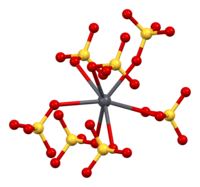Lead(II)_sulfate
Lead(II) sulfate
Chemical compound
Lead(II) sulfate (PbSO4) is a white solid, which appears white in microcrystalline form. It is also known as fast white, milk white, sulfuric acid lead salt or anglesite.
| Names | |
|---|---|
| IUPAC name
lead(II) sulfate | |
| Other names
Anglesite, fast white, milk white, plumbous sulfate | |
| Identifiers | |
3D model (JSmol) |
|
| ChemSpider |
|
| ECHA InfoCard | 100.028.362 |
| EC Number |
|
PubChem CID |
|
| UNII | |
| UN number | 1759 1794 |
CompTox Dashboard (EPA) |
|
| |
| |
| Properties | |
| PbSO4 | |
| Molar mass | 303.26 g/mol[1][2] |
| Appearance | white solid |
| Density | 6.29 g/cm3[3] |
| Melting point | 1,087 °C (1,989 °F; 1,360 K) decomposes |
| 0.0032 g/100 mL (15 °C) 0.0404 g/100 mL (25 °C)[4] | |
Solubility product (Ksp) |
2.13 x 10−8 (20 °C) |
| Solubility | insoluble in alcohol
soluble in ammonium acetate (≥ 6 mol/L) soluble in ammonium tartrate in presence of ammonium chloride and ammonia |
| −69.7·10−6 cm3/mol | |
Refractive index (nD) |
1.877 |
| Structure | |
| orthorhombic, barite | |
| Thermochemistry | |
Heat capacity (C) |
103 J/degree mol |
Std molar entropy (S⦵298) |
149 J·mol−1·K−1[5] |
Std enthalpy of formation (ΔfH⦵298) |
−920 kJ·mol−1[5] |
| Hazards | |
| GHS labelling: | |
   | |
| Danger | |
| H302, H332, H360Df, H410 | |
| P201, P202, P260, P261, P264, P270, P271, P273, P281, P301+P312, P304+P312, P304+P340, P308+P313, P312, P314, P330, P391, P405, P501 | |
| NFPA 704 (fire diamond) | |
| Flash point | Non-flammable |
Threshold limit value (TLV) |
0.15 mg/m3 |
| Related compounds | |
Other anions |
Lead(II) chloride, Lead(II) bromide, Lead(II) iodide, Lead(II) fluoride |
Other cations |
Tin(II) sulfate, Sodium sulfate, Copper(II) sulfate |
Except where otherwise noted, data are given for materials in their standard state (at 25 °C [77 °F], 100 kPa).
| |
It is often seen in the plates/electrodes of car batteries, as it is formed when the battery is discharged (when the battery is recharged, then the lead sulfate is transformed back to metallic lead and sulfuric acid on the negative terminal or lead dioxide and sulfuric acid on the positive terminal). Lead sulfate is poorly soluble in water.
Anglesite (lead(II) sulfate, PbSO4) adopts the same orthorhombic crystal structure as celestite (strontium sulfate, SrSO4) and barite (barium sulfate, BaSO4). All three minerals' structures are in the space group Pbnm (number 62).[6] Each lead(II) ion is surrounded by 12 oxygen atoms from 7 sulfate ions, forming a PbO12 polyhedron.[7] The lead–oxygen distances range from 2.612 Å to 3.267 Å and the average distance is 2.865 Å.[6]
| Lead coordination | Sulfate coordination |
|---|---|
 |
 |
Lead(II) sulfate is prepared by treating lead oxide, hydroxide or carbonate with warm sulfuric acid or by treating a soluble lead salt with sulfuric acid.
Alternatively, it can be made by the interaction of solutions of lead nitrate and sodium sulfate.
Lead sulfate is toxic by inhalation, ingestion and skin contact. It is a cumulative poison, and repeated exposure may lead to anemia, kidney damage, eyesight damage or damage to the central nervous system (especially in children). It is also corrosive - contact with the eyes can lead to severe irritation or burns. Typical threshold limit value is 0.15 mg/m3.
The naturally occurring mineral anglesite, PbSO4, occurs as an oxidation product of primary lead sulfide ore,
A number of lead basic sulfates are known: PbSO4·PbO; PbSO4·2PbO; PbSO4·3PbO; PbSO4·4PbO. They are used in manufacturing of active paste for lead–acid batteries. A related mineral is leadhillite, 2PbCO3·PbSO4·Pb(OH)2.
At high concentration of sulfuric acid (>80%), lead hydrogensulfate, Pb(HSO4)2, forms.[8]
Lead(II) sulfate can be dissolved in concentrated HNO3, HCl, H2SO4 producing acidic salts or complex compounds, and in concentrated alkali giving soluble tetrahydroxidoplumbate(II) [Pb(OH)4]2− complexes.
- PbSO4(s) + H2SO4(l) ⇌ Pb(HSO4)2(aq)
- PbSO4(s) + 4 NaOH(aq) → Na2[Pb(OH)4](aq) + Na2SO4(aq)
Lead(II) sulfate decomposes when heated above 1000 °C:
- PbSO4(s) → PbO(s) + SO3(g)
- Lead-acid storage batteries[9]
- Paint pigments[9]
- Laboratory reagent[9]
- "Molar Mass of Lead Sulphate". webbook.nist.gov. Archived from the original on 13 December 2020. Retrieved 4 March 2022.
- "NIST data review 1980" (PDF). National Institute of Standards and Technology (NIST). Archived from the original (PDF) on 21 December 2016. Retrieved 4 March 2022.
- Lide, David R. (14 September 2002). "CRC Handbook of Chemistry and Physics. 83rd Edition". Journal of the American Chemical Society. 124 (47). National Institute of Standards and Technology (NIST); CRC Press: Boca Raton: 14280. doi:10.1021/ja025295q. ISBN 9780849304835. ISSN 0002-7863. OCLC 956588069. Archived from the original on 4 March 2022. Retrieved 4 March 2022.
- PubChem. "Lead sulfate". pubchem.ncbi.nlm.nih.gov. Archived from the original on 29 November 2021. Retrieved 2022-03-04.
- Zumdahl, Steven S. (2009). Chemical Principles (6th ed.). Houghton Mifflin Company. p. A22. ISBN 978-0-618-94690-7. OCLC 1029017812.
- Antao, Sytle M. (2012). "Structural trends for celestite (SrSO4), anglesite (PbSO4), and barite (BaSO4): Confirmation of expected variations within the SO4 groups". Am. Mineral. 97 (4): 661–665. doi:10.2138/am.2012.3905. S2CID 55149411.
- Wells, A. F. (1984). Structural Inorganic Chemistry (5th ed.). Oxford University Press. p. 1187. ISBN 978-0-19-965763-6.
- "Министерство образования и науки РФ, Реферат "Свинец и его свойства"" [Abstract: Lead and its properties]. Ministry of Education and Science of the Russian Federation. 2007. Archived from the original on 21 December 2007.
- Hazardous Substance Fact Sheet (PDF), September 2007